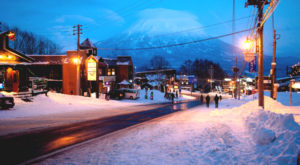 I AM barefoot and naked padding along a stone path in the depths of Japanese winter, surrounded by snow-laden pine trees. I slip into a hot pool fed by natural underground springs. Huge, slow-moving snowflakes gently settle on my hair. In the dusk I can see just a few vague figures across the pond-size area — other women barely visible through the steam.
I AM barefoot and naked padding along a stone path in the depths of Japanese winter, surrounded by snow-laden pine trees. I slip into a hot pool fed by natural underground springs. Huge, slow-moving snowflakes gently settle on my hair. In the dusk I can see just a few vague figures across the pond-size area — other women barely visible through the steam.
Earlier that day I had been communing with the snow in a more conventional way, skiing my way through deep blankets of powder on Mount Annupuri in Niseko. The network of ski areas around the small resort village of Hirafu on Hokkaido, Japan’s northernmost island, see almost constant snowfall from December to April, a type of “Champagne powder,” as aficionados call it, that is a result of low pressure systems over northeast Hokkaido meeting high pressure systems over northwest Siberia. The winds from Siberia pick up moisture from the Sea of Japan, and the resulting bands of clouds dump huge amounts of snow when they reach the mountains.

